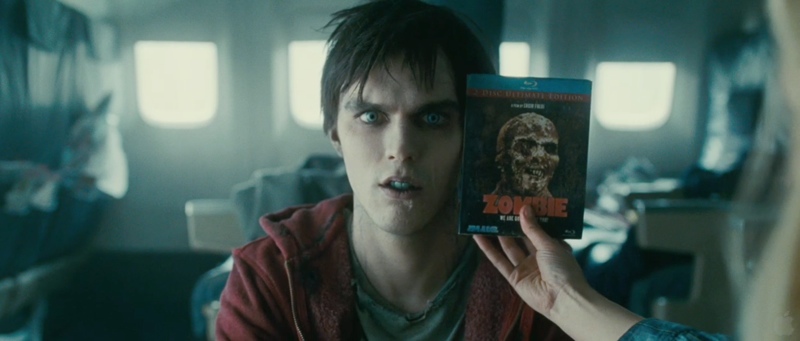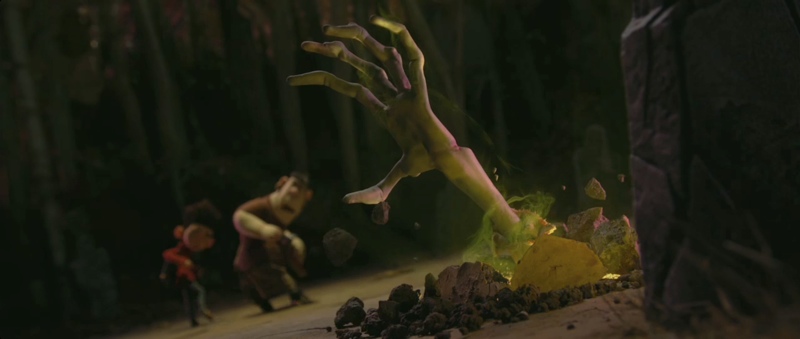2013 // USA // Jonathan Levine // January 29, 2013 // Digital Theatrical Projection (Wehrenberg Ronnies 20 Cine)
Zombie films are now such a ubiquitous aspect of contemporary pop culture, it’s difficult to believe that a little more than a decade ago the subgenre was in a bit of slump. A mere month after George Romero’s original Living Dead trilogy was completed in July of 1985, the sophomoric goofiness and embarrassing “punk” aesthetic of the Return of the Living Dead franchise rose up to take its place. Occasional bright spots such as Tom Savini’s remake of Night of the Living Dead (1990) and Ryuhei Kitamura’s undead-against-yakuza feature Versus (2000) managed to keep the zombie flame alive during those dark days. However, it wasn’t until 28 Days Later hit the ground running in 2002 that the zombie tale was truly reborn as a borderline-respectable cluster of horror conventions, one that could eventually support lavishly produced hour-long television dramas. This resurrection happened quickly, too, if one can assess the maturity of a trend by events of sub-subgenre fission. Only two years passed between 28 Days and Shaun of Dead (2004), the first post-revival zombie comedy and unquestionably the finest example of the form.
Sadly, the zombie comedy has had a lackluster unlife in the wake of Shaun, delivering one reasonably strong also-ran (Zombieland) and a string of forgettable features that range from the merely dull to the howlingly unfunny (Dead & Breakfast, Boy Eats Girl, Fido, Dance of the Dead, Dead Snow). Writer-director Jonathan Levine’s new film, Warm Bodies is the latest clammy-skinned hopeful in this particular category of cinema, and unfortunately it stumbles far more often than it succeeds.
Adapted from Isaac Marion’s post-apocalyptic “zombie romance” novel of the same name, the film strikes an unusual tone that is somehow both earnest and acerbic. Its narrative is a rather shameless mash-up of warmed-over love story fragments: both Romeo and Juliet and Beauty and the Beast lend their contours to the story. The former work, in fact, is referenced so overtly that the film is practically a zombie retelling of the Bard’s tragedy (with a happy ending!). Warm Bodies presents the bland, star-crossed romance between awkward pretty-boy zombie R (Nicholas Hoult) and tough, sensitive human Julie (Teresa Palmer) in a blithely matter-of-fact way. (R and Julie: get it?) The ardor of their forbidden love is more asserted than illustrated through dialogue or action, and Hoult and Palmer lamentably don’t have much chemistry with one another. Levine’s screenplay dresses up this tale of necrophilic puppy love with doses of tiresome action-horror and equally tiresome science-fiction allegory, but these elements only serve to draw attention to the thin, unengaging romance.
Yet despite the straightforward, shallow stance that the film assumes towards its central love story, Warm Bodies strives to be a satirical riposte to the serious-minded angst of most fictional adolescent romance. The resulting tone is damn strange. While the film never feels phony, there is a smug heedlessness in the way that its winking ridicule is scrawled in between moistened, unconvincing declarations of emotion. To the film’s credit, R’s professions of love are groaned in a gurgling Tarzan pidgin, consistently underlining the vacuousness of the couple’s fairy tale yearnings. However, this sardonic impulse never convinces, if only because the film is never truly bloody-minded about attacking mindless storytelling formulae.
Nonetheless, Warm Bodies does score some critical hits against deserving targets: the leaden longing of post-Twilight young adult lit; the creepiness of male characters in Sundance-bait relationship films; or the rotten, god-awful cliches of mainstream romantic comedy cinema. (One standout gag involves a character putting a screeching halt to the use of “Oh, Pretty Woman” during a Makeover Scene.) Most of the film’s mockery is delivered loudly and unambiguously—often via R’s pointedly ironic internal voice-over—but there are some exceedingly sly moments here and there. When R haltingly insists on the superiority of vinyl over digital music, it’s presented in such a deadpan manner that it’s difficult to discern if the script is satirizing actual music snobs, the Hollywood conception of music snobs, or the lazy use of music snobbery to denote character depth. The film’s humor really only falls flat when it lamely attempts to ape Shaun of the Dead by pointing out the similarities between the pre- and post-undead worlds.
Zombie movie purists will likely find the entire premise of Warm Bodies objectionable on a certain level. The story is predicated on R having retained a sliver of intelligence and emotion within his moldering brain, an idea that flies in the face of the normally strict depiction of the living dead as mindless horrors that are beyond salvation. What’s more, the plot presents Juliet’s love for R as a sort of redeeming contagion, capable of stirring not only her undead boyfriend’s putrid heart to beat, but also the blood of other zombies with whom he comes into contact. While this concept is faintly ridiculous, it’s not self-defeatingly stupid, nor is its contravention of zombie tropes especially bothersome. Works of fiction can, after all, posit whatever rules that the creator wishes, and there’s only so many living dead films that can be made in the unremittingly bleak mode of 28 Weeks Later and [REC]. Far more annoying than the film’s conceit of a curable undeath is its failure to play fair by its own rules. The zombies seem to move slowly, until the plot necessitates that they need to sprint. They can smell human flesh with shark-like precision, but are easily bamboozled by a smear of undead ooze.
These might seem to be the nitpicky gripes of a horror obsessive, but they are indicative of the slipshod quality to the broader story. The filmmakers add a third prong to the human-vs.-zombies conflict in the form of the feral, desiccated “Bonies”: living dead who have become sightless, walking strips of beef jerky. It’s an arguably necessary device in order to maintain a sense of threat even as the less monstrous “Corpse” zombies are being humanized, but it nonetheless seems narratively cheap. There is an obligatory showdown with the Bonies in the film’s final act, during which the spacial relationships between the three factions are so hopelessly muddled that it’s unclear where the hell events are even occurring.
Indeed, the geography of the film’s post-apocalyptic landscape is downright ridiculous at times. R force-marches Juliet from the human survivors’ walled city to the zombie-infested airport in an afternoon, but their later return by car inexplicably takes a couple of days. The majority of the interior spaces are governed by a kind of fractured geometry: subterranean crawl spaces seem to connect to parking ramps, which connect to subway stations, which connect to baseball stadiums, which connect to chemistry labs. This sort of careless disregard for spatial coherence is the marker of a third direct-to-DVD horror sequel, not a theatrical film in wide release (even if it is a February wide release). Ultimately, the biting humor that Warm Bodies occasionally exhibits is not sufficient grounds to overlook either the banal romantic plot or the laxness of the film’s construction.









